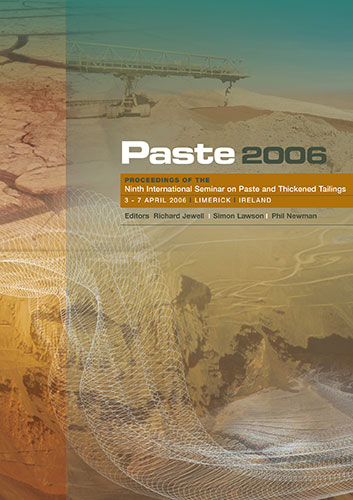Design and Commissioning of the Lisheen Backfill Plant

|
Authors: Shaw, A; MacNamara, L Paper is not available for download Contact Us |
DOI https://doi.org/10.36487/ACG_repo/663_30
Cite As:
Shaw, A & MacNamara, L 2006, 'Design and Commissioning of the Lisheen Backfill Plant', in R Jewell, S Lawson & P Newman (eds), Paste 2006: Proceedings of the Ninth International Seminar on Paste and Thickened Tailings, Australian Centre for Geomechanics, Perth, pp. 347-358, https://doi.org/10.36487/ACG_repo/663_30
Abstract:
The Lisheen Mine is the most recent mining development in Ireland, Europe’s largest zinc producing country and has been operating since 1999. The mine is owned and operated by Anglo Base Metals, a division of Anglo American plc. Initially planned and developed over ten years ago, the mine backfill was part of the life of mine plan from the start of the project. Backfill in the mine would serve two purposes; facilitation of secondary pillar removal and underground tailings disposal. The topography of the deposit resulted in a mine plan which predominately used Room and Pillar mining. Here backfill could be used as a means of ground support for pillar recovery. The permits granted for the mining and milling operation restricted the available area for tailings disposal and imposed a height restriction on the embankment, effectively fixing the capacity of the Tailings Management Facility (TMF) and enforcing the use of backfill as a means of waste disposal. A detailed study into the characteristics of the concentrator tailings was carried out in 1999, including pipe loop testing and strength testing. When the characteristics of the mill tailings and the topography of the deposit were taken into consideration, a backfill system using total tailings with single stage tank dewatering was deemed to be the most suitable. After a two week pilot trial, an 18m diameter Eimco Deep Cone Thickener (DCT) was installed as part of a 4000 tpd cemented paste backfill plant to place tailings with a minimum in situ strength of 500 kPa into the secondary stopes, allowing pillar recovery with a target ore extraction level in excess of 95%. Commissioned in October 2004, the first twelve months of operation saw 358000 m3 of tailings placed underground, approximately 55% of the tailings produced by the concentrator.
© Copyright 2025, Australian Centre for Geomechanics (ACG), The University of Western Australia. All rights reserved.
View copyright/legal information
Please direct any queries or error reports to repository-acg@uwa.edu.au
View copyright/legal information
Please direct any queries or error reports to repository-acg@uwa.edu.au